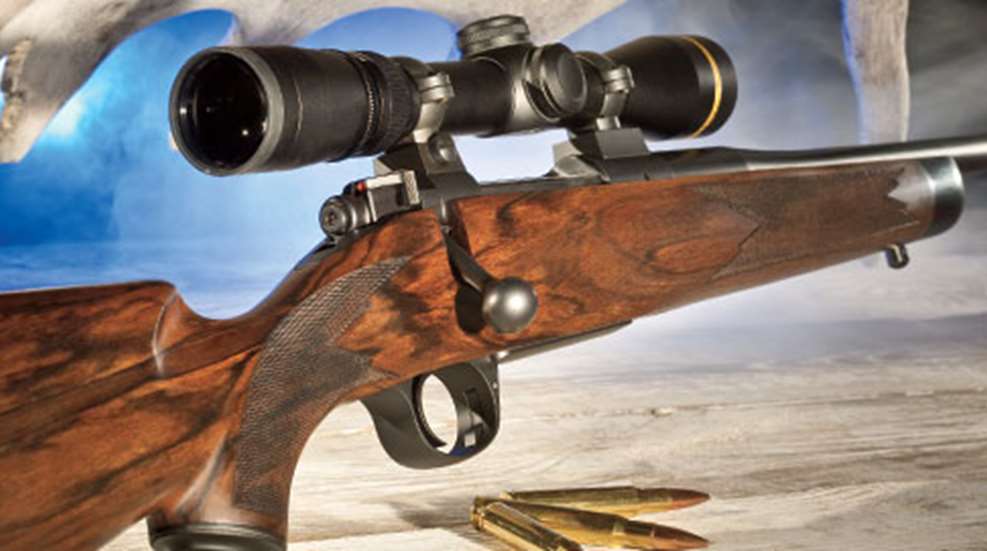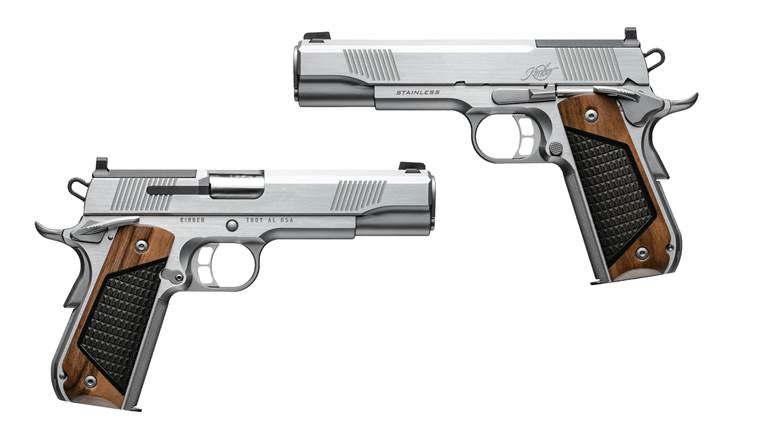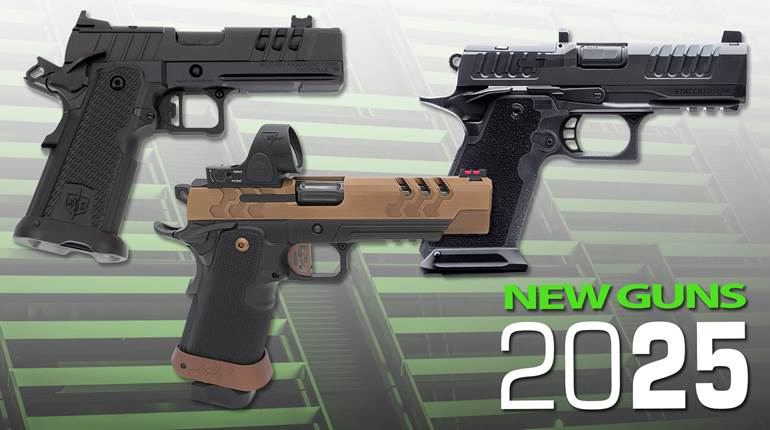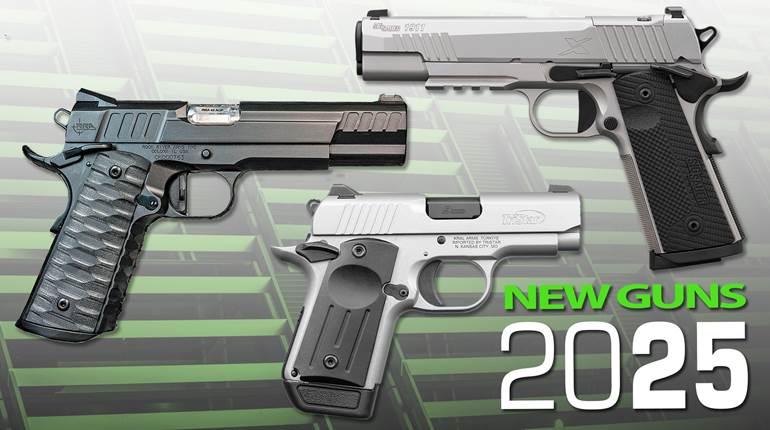
I know I’m likely jeopardizing my membership in the loyal order of traditionalist gun writers, but my post-’64 Model 70 Featherweight has been looking, well, portly these days. Rubenesque even. It’s not that my Model 70 needs to go on diet, but when compared to the Kimber Model 84L, it simply doesn’t have the slender lines I once thought it had.
The new 84L is a long-action, turnbolt magazine repeater designed specifically around the .30-’06 Sprg. cartridge. Offered initially in .30-’06 Sprg., .25-’06 Rem. and .270 Win., it is a minimalist approach to rifles in this class. Like the minimalist schools of art and music, simplicity is the key, eschewing the excessive and unnecessary. This rifle isn’t designed to take larger, fatter, higher-pressure cartridges than .30-’06 Sprg., so no dimension is greater than it absolutely needs to be. It is a ’tween gun falling squarely between the firm’s Model 84M and 8400. In its effort to adapt the 84M to America’s cartridge, Kimber has created a new category of factory bolt-action rifles with the Model 84L.
To back up a little, the 84L is the latest of the “modern” American-made Kimber Mfg. bolt-actions. Modern is defined by the creation of Kimber Mfg. in Yonkers, N.Y., in 1997, which followed the closing of the late Greg Warne’s Kimber of Oregon (1980 to 1991), and the passing of the Kimber of America era from 1993 to 1997. In rifles, it began with the short-action Model 84M.
The 84M was designed by Nehemia Sirkis for Kimber and built completely around the .308 Win. cartridge. At 5 pounds, 11 ounces, the Claro walnut-stocked rifle was comparable to the petite Mauser small-ring sporters of the interwar era. Introduced three years later, the Model 8400 was designed around the pressures and 0.555-inch case diameter of the .300 WSM cartridge. At nearly 7 pounds, the Model 8400 in .30-’06 Sprg. was svelte but not ground-breaking in terms of weight savings. And the ejection/loading port on the Model 8400 was 3.51 inches, just long enough to accommodate lengthy dangerous-game cartridges such as the .375 H&H Mag., and now the .416 Rem. Mag. and .458 Lott, spawning the blued steel and walnut Caprivi and the stainless and synthetic Talkeetna.
For decades the gold standard in American factory-made .30-’06 Sprg. rifles has been the Model 70 Featherweight introduced in 1952. Winchester trimmed up the stock, employed aluminum alloy bottom metal and lopped 2 inches off the barrel to get a nominal half-pound savings in weight. The long action used for .30-’06 Sprg. Featherweights was the same used for larger cartridges up to and including .458 Win. Mag. As graceful as they are, Featherweights still use full-size receivers and full-diameter bolts. It’s not so much pounds and ounces that set the Featherweight apart so much as its lines, especially its slim stock and Schnabel fore-end tip.
A team of Kimber engineers picked up where the Model 84M left off, basically stretching the action, bolt and other components 0.52 inches into a long action with a 3.174-inch-long ejection port. The 84L’s receiver is 8 5/16 inches from the receiver ring’s front to the end of the tang and 1.14 inches in diameter, while a current Model 70’s action is 9.25 inches long, and its receiver measures 1.34 inches in diameter at its narrowest point. The 84L’s cylindrical bolt body measures 0.58 inches in diameter and is 6.54 inches long. Not to pick on the “Rifleman’s Rifle” too much, but a current-production Model 70 .30-’06 Sprg. bolt weighs 14 ounces, measures 7.51 inches long, and its body is 0.705 inches in diameter. The weight of the 84L’s bolt is 9 ounces on the nose, which equates to a weight savings of 5 ounces for the bolt alone.
The weight of the 24-inch-barreled 84L Classic Select sample rifle was 6 pounds, 2 ounces, without a scope, rings or bases, and equipped with a Leupold VX-III 1.75-6X 32 mm scope, Leupold bases and rings, it weighed 6 pounds, 15 ounces—less than most comparable factory rifles unscoped. In fairness to my friends at Winchester, to get a 6-pound, 4-ounce rifle (unscoped) in a .30-’06 Sprg. from Remington, the only option is the 24-inch-barreled Model 700 Alaskan Ti with a full-diameter titanium receiver, a full-diameter fluted bolt and a $2,225 price tag. Browning’s A-Bolt Mountain Ti (also with a full-size titanium receiver) with a 23-inch barrel comes in under the Kimber at 5 pounds, 8 ounces, but you can’t get it in .30-’06 Sprg. Priced at $1,979, it’s a WSM-only proposition. Due to the use of titanium, the receivers on both guns are lighter but larger than the Kimber.
The 84L’s bolt is a cylindrical, two-lug design with an external, 0.360-inch-wide, 4.33-inch-long, Mauser-style claw extractor on the right. The blued handle has a smooth knob and is threaded into the bolt body to ease manufacture. The body has two gas relief holes in its underside (in addition to the one on the receiver), and it is polished in the white while the shroud and smooth, uncheckered handle have a matte-blue finish.
The three-position firing pin-blocking safety on the bolt shroud resembles that of the Model 70. In the forward-most or “off” position, a recessed red dot is revealed. The middle position locks the firing pin, and fully rearward blocks the firing pin and prevents bolt manipulation.
A rail is cut on the left and right sides of the receiver’s interior that the bottom of the bolt lugs bear against, which reduces binding or wobble while cycling the bolt. Bolt operation, by the way, is very smooth. The spring-loaded ejector is pinned in the bottom, left side of the receiver. Depressing the grooved rear of the spring-loaded release on the receiver’s left rear frees the bolt for removal.
The adjustable, single-stage trigger is set at the factory to break at 3 pounds, 8 ounces to 4 pounds, and the sample rifle’s trigger went slightly less at 3 pounds, 6 ounces. There was no creep, minimal take-up, and it broke crisply with little overtravel. There was not much room for improvement, so I left the trigger alone.
The 84L comes in two variations at present, the Classic and the Classic Select. The former features a walnut stock, while the latter comes with a French walnut stock and an ebony fore-end tip. The figure and grain on the tested Select was simply breathtaking. Checkering is in a 20 line-per-inch bordered point pattern, and it adorns the wrist and fore-end. It was well-executed with few overruns and no flattened points. The semi-pistol grip is capped by a blue grip cap, and the grip is open and in the American style with a generous radius. It is assuredly not a knuckle-cracker. The wrist and fore-end are thin and graceful, and aid in the gun’s quick handling. Topping the butt is a 1-inch-thick, black Pachmayr Decelerator recoil pad set off by a black spacer, and quick detachable sling swivel studs are standard.
The matte-blue steel trigger guard and hinged floorplate (from the exterior they appear to be one assembly) are secured together by three Allen screws, and the entire assembly is retained by the stock screws at the front and rear. Depressing the spring-loaded release button on the inside front face of the trigger guard frees the floorplate to swing open. The follower is black polymer, and power for the magazine is supplied by a blue steel “W”-spring. A blue stamped steel magazine body is sandwiched between the action bottom and the bottom metal’s top. Magazine capacity is five rounds, and one can depress the top round in the magazine and drop a cartridge onto the feedway for a total of six rounds.
The 24-inch-long barrel has a match-grade chamber (tight but not so much as to impede reliability) with six-groove, 1:10-inch RH twist rifling, and the 4140 steel barrel is finished with a recessed, target-style crown. The barrel measures 1.04 inches at the receiver joint, and its light sporter contour tapers gracefully to 0.559 inches at the muzzle. To enhance accuracy, both the front and rear action screws are pillar bedded, and the aluminum pillars are glass-bedded into the stock. The action is bedded, as is the recess for the recoil lug. The recoil lug is a separate component that is collar mounted during assembly, much like that of the Remington Model 700. It measures 1.88-inches wide and 0.88-inches thick.
With the 84L’s introduction, Kimber is changing its sporter line-up. Short-action cartridges from .223 Rem. through .338 Federal remain the purview of the 84M, but the Model 8400 is now primarily a platform for the Winchester Short Magnum cartridges: .270 WSM, .300 WSM and .325 WSM. In its “standard” magnum offerings, 8400s may be had in 7 mm Rem. Mag., .300 Win. Mag. and .338 Win. Mag. Conspicuously absent at present is the .243 Win. The first 475 .30-’06 Sprg. Model 84Ls were shipped to the Rocky Mountain Elk Foundation, but guns should be flowing to dealers by the time of this writing
At the bench the 84L proved to be quite accurate—averaging slightly more than an inch at 100 yards for five consecutive, five-shot groups—but with its slim barrel, care had to be taken to allow the barrel to cool between groups for best accuracy. This was abetted by 22-degree F temperatures on range day. Through the course of more than 120 rounds downrange for accuracy and function testing, the 84L Select performed well and without a hitch. It may supplant my .308 Win. 84M Montana as my go-to gun; only time will tell.
In terms of handling, the 84L is a very lively gun that comes to the shoulder quickly and surely. As one colleague put it, “This thing points like a fine English gun.” But it doesn’t come with the price tag of a fine English gun. There’s no danger of this rifle appearing on the discount rack of a big box store, but for its features and quality the rifle is fully commiserate with the asking price of $1,359. The Classic, in “regular” walnut and without the fore-end tip is priced at $1,172.
The 84L is the rifle I wanted from Kimber all along—a lightweight, elegant minimalist sporter built on classic lines with admirable accuracy, but chambered for America’s cartridge. And, at least for now, it’s in a class by itself.
Manufacturer: Kimber Mfg., Inc.; (800) 880-2418; Kimberamerica.com
Caliber: .25-’06 Rem., .270 Win.,.30-’06 Sprg. (tested)
Action Type: Bolt-action, repeating center-fire rifle
Receiver: 4140 steel
Finish: Matte blue
Magazine Capacity: Five rounds
Overall Length: 437⁄8"
Barrel: 24" light sporter contour
Rifling: Button-rifled, six-groove, 1:10" RH twist
Weight: 6 lbs., 2 ozs. (empty, unscoped)
Sights: None, drilled and tapped for Kimber scope bases
Trigger Pull: Adjustable, single-stage; 3 lbs., 6 ozs.
Stock: French walnut: length of pull, 135⁄8"; drop at heel, 9/16"; drop at comb, 7/16"
Accessories: Cable lock, manual
Suggested Retail Price: $1,359





































